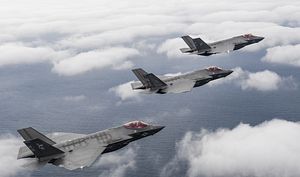On September 7 it was confirmed that deliveries of F-35 fifth generation fighters had been placed on hold by the Pentagon after the discovery that magnets used in its Honeywell-supplied turbomachine pumps had been acquired from Chinese sources. Two days later it was announced that the F-35 Joint Production Office would seek a waiver, without which the production run of over 140 airframes per year could be placed at serious risk.
Far from an isolated development, this reflected part of broader and growing difficulties the United States military has had with its industrial supply chains as a result of the contraction of U.S. defense and civilian industries since the end of the Cold War. The shrinking of these industries has made foreign inputs, particularly from East Asia, increasingly indispensable for key U.S. weapons programs.
As the world’s largest-ever weapons program, the future backbone of NATO and allied fleets, and for years the only fighter the U.S. Air Force was acquiring, the F-35 serves as a potent symbol of a wider trends affecting the United States’ defense sector and its post-Cold War weapons programs. Its turbomachine pump is hardly the first part of the aircraft found to be reliant on Chinese inputs. Indeed, the Pentagon previously provided a waiver to allow their use in the fighter program’s early stages as not doing so would have caused unacceptable delays to a development effort already several years late. This was despite China, which has since emerged as the only other country to field indigenous fifth generation fighters, already widely being considered the primary target of future F-35 deployments, highlighting the country’s centrality in supply chains for high tech products.
Alongside China, further very significant inputs into the F-35 have long been sourced from Taiwan, which is permitted to remain a key supplier due to the indispensability of its world-leading electronics and semiconductor industries. It also does not include the reliance on inputs from firms located in friendly countries that are under Chinese ownership – a notable example being British-built core circuit boards, which Lockheed Martin initially denied were from a Chinese-owned firm before this was confirmed in 2019.
There is a not insignificant chance that further Chinese inputs into the F-35 will be discovered in future, particularly as U.S. firms have in the past sought to disguise the Chinese origins of their products to supply the military – Adventura Technologies being a notable example. This is aside from inputs of rare earth minerals from China; if supplies were cut, it could seriously hinder the program. China provides over 85 percent of the world’s rare earths, and approximately 417 kilograms of them are required to produce each F-35.
As a consequence of the tectonic shift in global industry and high tech toward East Asia, analysts at the National Interest questioned in 2018 “whether it is even possible anymore to make purely American weapons,” highlighting the low feasibility of reshoring production to the United States. Defense journalist Brett Tingley was among many to underline three years later: “currently, the U.S. is almost entirely reliant on foreign-made electronics to power most of its technologies, both in the defense and consumer sectors.” He stressed that this had very significant implications both for civilian high tech’s ability to compete as well as for the defense sector. Since globalization of tech supply chains and a decline a civilian high-tech manufacturing in the 1990s coincided with a shrinking defense budget, and thus an increasing impetus toward outsourcing, the self-reliance of the U.S. defense sector has been in sharp decline.
A notable result was the widespread opposition to calls in the 2000s for regulations mandating a return to reduced foreign inputs into products going to the Pentagon. In 2003, for example, the Aerospace Industries Association opposed calls for greater reliance on U.S.-made equipment on the basis that restricting foreign imports would not only significantly raise the costs, but would also prevent access to many of the most advanced electronics and information technologies. Flat panel displays, which were no longer made in the United States, were highlighted as an example. As the discrepancies between U.S. and East Asian high-tech industries, and that of China in particular, continued to grow, this issue has only become more serious.
Industrial trends not only place American supply chains at greater risk, particularly in wartime, but also place Chinese defense products at an advantage due to the much larger scale of R&D and larger civilian industrial base and scale of high-tech manufacturing which they can draw from. Flat panel displays are but one example of a key input that can be sourced locally for China’s J-20 stealth fighter, but cannot for the F-35. Greater concentration of high-tech manufacturing has also been repeatedly linked to greater levels of innovation, the results of which will likely become more conspicuous over the coming decade.
Industrial trends portend that the U.S. defense sector will face not only greater difficulties ensuring components come from politically favorable actors, but also greater struggles in keeping up with advances in Chinese armaments and the degree of supply chain security they enjoy. Meanwhile the incentives to disguise the origins of Chinese and other East Asian inputs for U.S. weapons systems will continue to grow as it becomes more difficult and more costly to source inputs locally – an issue compounded by the fact that even today’s friendly overseas suppliers may in future be seen as less reliable.
The key to the United States’ ability to produce world leading weapons systems during the Cold War was its central position in global high tech and the near unrivaled scale of its advanced industries, positions which have fast diminished since the 1990s and continue to do so. Reliance on foreign inputs for its weapons programs, and the strong incentives firms will have to integrate Chinese and other foreign technologies and components into them, is but one of the many consequences.

































